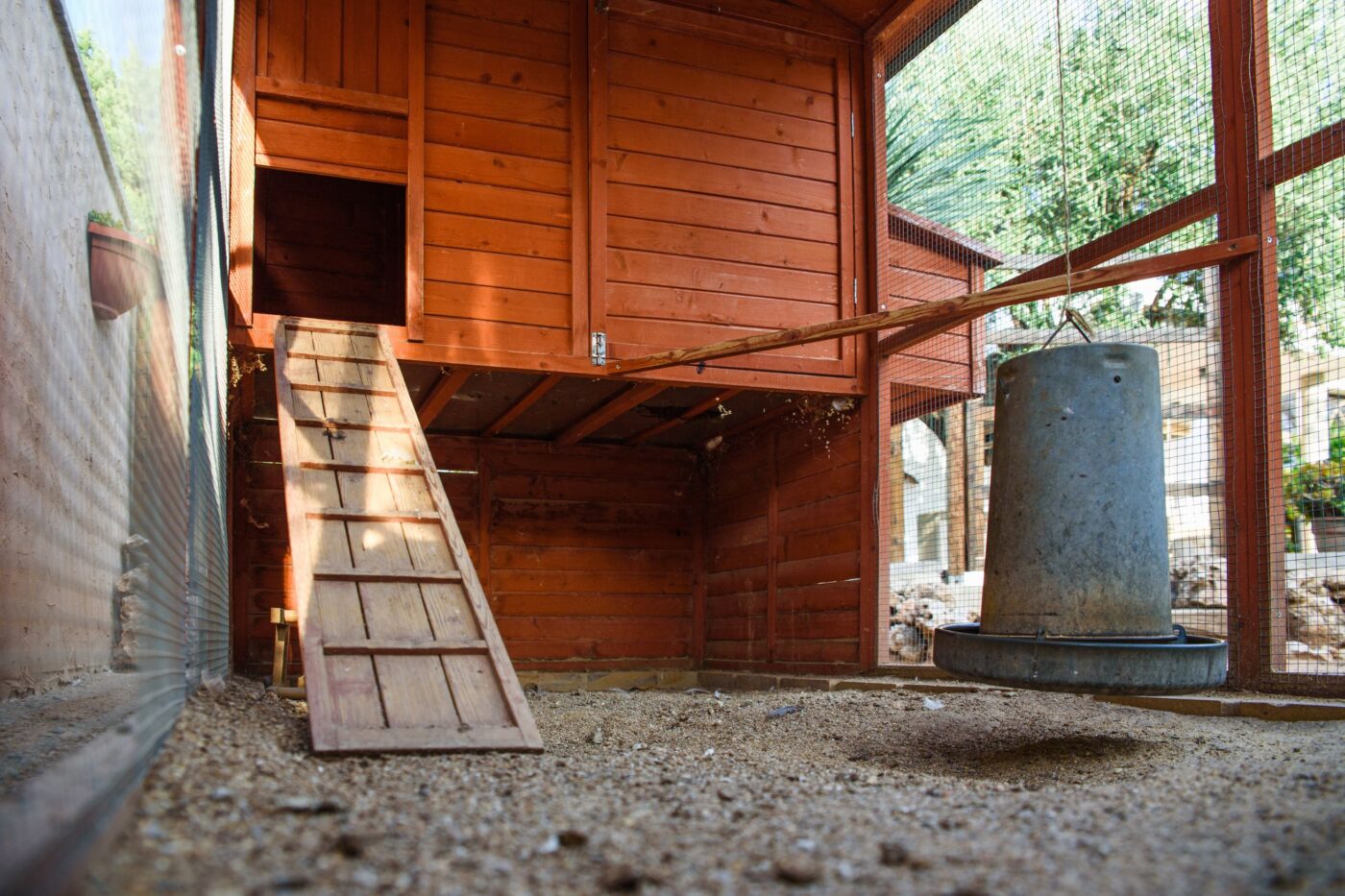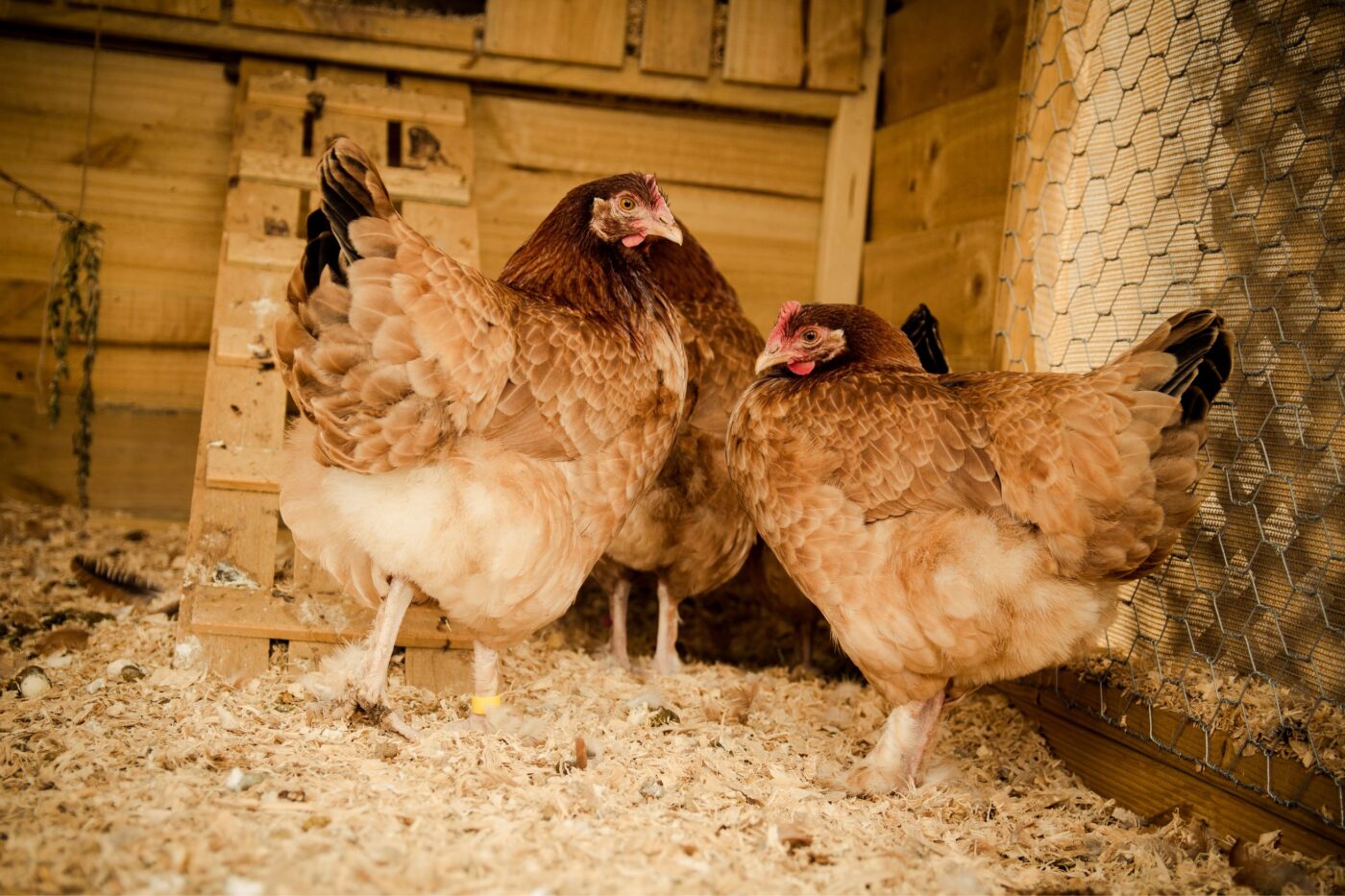Is cleaning a chicken coop really that important? Neglecting to clean out your chicken coop regularly puts your flock at risk of infection. People who don’t clean their wooden chicken coops often can lose chickens to diseases that could have been avoided by cleaning the coops often. Keeping your chicken coop clean will reduce the chances of spreading germs and help you keep your flock healthy.
If you want some more tips and information about how to raise backyard chickens, check out this article.
Cleaning the floors, getting rid of any mold and litter, cleaning the nesting boxes, and changing your chicken’s bedding will kill the germs and reduce the possibility of spreading germs inside your chicken coop.
If you don’t clean your chicken coop regularly, bacteria and other diseases can grow in the coop. This can make your chickens sick and could even make you or your family members sick from taking care of the chickens. So, this is why it’s important to clean your chicken coop regularly. Here’s a step-by-step guide on cleaning a chicken coop and learning how to keep your chickens healthy and happy.
It’s important to keep your chicken coop clean if you want to raise healthy, happy chickens. On the other hand, it can be hard to figure out how often you need to change the sheets. Changing the bedding too frequently wastes time and money. Bugs and ammonia can build up if you wait too long, which is bad for the health of your flock. So what’s the right amount? Keep reading to find out what you should think about when deciding how often to change the bedding in your chicken coop.
Why Chicken Coop Bedding Needs Changing
Before we talk about how often to change the bedding, let’s talk about why it’s so important.
Getting rid of waste: Bedding picks up poop, food, and water that gets spilled. This keeps the coop floor relatively clean and dry.
Odor control – Regular changing prevents ammonia odor from droppings building up.
Reducing flies and pests – Clean bedding deprives flies and parasites of a place to breed
Avoiding respiratory issues – Ammonia and dust can irritate chickens’ airways Fresh bedding prevents this
Promoting health – Cleanliness wards off disease-causing germs and parasites like mites.
Encouraging natural behaviors – Chickens love to scratch and dust bathe in loose bedding.
So keeping the bedding fresh is fundamental to your chickens’ health and wellbeing. But what’s the optimal schedule?
Factors That Determine How Often to Change Chicken Bedding
There is no set rule for how often you should change the sheets. The right schedule depends on several factors:
Number of Chickens
It stands to reason that the more chickens you have, the quicker the bedding will become soiled. For a small flock of 2-6 birds you may only need to change it every 2-4 weeks. But for 12+ chickens you’ll probably need to change at least weekly.
Coop Size
Again, this is common sense. A large coop will allow you to go longer between changes. But when housing many chickens in a small space, aim for at least weekly changes.
Types of Bedding
Some materials like sand tend to stay cleaner longer than others like straw. Paper-based beddings are very absorbent but can cake up. Wood shavings are a good middle ground. Know your bedding.
Local Weather Conditions
Hot, humid climates can cause bedding to become damp and ammonia-ridden faster than drier areas. You’ll likely need to change more often in these conditions.
Cleaning Habits
Spot cleaning droppings between changes extends the life of bedding. If you don’t do this, you’ll need to change it out more frequently.
Time of Year
In hot summer months, aim for weekly changes. You can likely get away with less often in winter. Deep winter freezes may even allow you to simply layer new bedding over old.
Signs It’s Time for a Bedding Change
Rather than rely on a rigid schedule, it’s good to also watch for signals from the bedding itself:
-
Strong ammonia smell – This indicates a buildup of droppings.
-
Visible caking/clumping – Bedding is excessively soiled and compacted.
-
Very dusty – Time to swap it out before respiratory issues occur.
-
Damp patches – Wet bedding promotes mold and bacteria.
-
Evidence of pests – Fleas, mites and flies breed in dirty bedding.
-
Chickens avoiding coop – They instinctively avoid ammonia and pests.
-
Lack of scratching/dust bathing – Chickens dislike interacting with soiled bedding.
How Often Experts Recommend Changing Chicken Bedding
Most backyard chicken guides recommend the following general schedules:
- Small flocks in large coops – Every 2-4 weeks
- Medium flocks – Weekly
- Large flocks in small coops – Twice weekly
However, they stress the importance of taking into account all the factors previously discussed.
For example, The Happy Chicken Coop recommends a weekly change for most flocks. But they advise more frequent changing for brooders due to the high volume of waste chicks produce.
Thompson & Morgan suggest layering new bedding over old during winter. But removing all bedding for a thorough clean-out at least twice a year.
The Hen House says aim for weekly changes. But monitor ammonia levels using your nose, and be prepared to change more or less often as needed.
Chicken Keepers Share How Often They Change Bedding
To get an idea of real-world schedules, here is what chicken keepers in online forums say about their bedding change frequency:
-
“I have a small flock in a large coop and only change it every 4-6 weeks.”
-
“With 12 chickens I have to change it weekly, especially in summer.”
-
“It’s a lot of work so I only do a full clean twice a year. But I spot clean droppings and wet areas.”
-
“I use sand that seems to stay fairly clean. I change it every 2 months or so.”
-
“With 18 birds in a small coop, I have to change it 2-3 times per week.”
-
“I wait as long as I can between changes. My coop never smells bad.”
-
“I do a full clean first spring, layer new on old for winter, then fully change again next spring.”
Best Practices When Changing Chicken Coop Bedding
Once you’ve decided it’s time for a change, follow these best practices:
-
Remove all old bedding and droppings – right down to the bare floor.
-
Clean the coop surfaces with a non-toxic disinfectant cleaner.
-
Allow the coop to fully dry before adding fresh bedding.
-
Choose an absorbent bedding material appropriate for local climate conditions.
-
Spread the new bedding 3-6 inches thick – experiment to find ideal depth.
-
Replace any dirty nesting box bedding at the same time.
-
Dispose of old bedding carefully if disease was present. Or compost it safely.
-
Monitor ammonia levels in the days after changing and adjust schedule accordingly.
Finding the Right Routine For Your Flock
When deciding how often to change chicken coop bedding, start by following general guidelines based on your specific situation. Then fine-tune your schedule according to the signs the bedding itself displays, your local climate, cleaning habits and preferences. Stick to a regular routine, but be flexible.
The most important thing is keeping the coop hygienic. But you also want to avoid wasting time and bedding material with excessively frequent changes. Finding the perfect balance takes some trial and error. The comfort and health of your flock are well worth the effort.
For most backyard flocks, planning to change the coop bedding weekly is a sensible starting point. Then monitor ammonia odor levels and how soiled the bedding appears. Increase frequency during hot weather or if housing lots of chickens. Decrease when possible in winter or with low chicken density. Employing best practices when changing bedding will help keep your flock healthy and productive. But being willing to tweak your routine based on close observation is key to coop cleanliness.

3 Methods to Keep Your Chicken Coop Clean

Keeping your coop well-maintained will help to keep your flock safe and healthy. According to other chicken coop owners, a well-maintained chicken coop could provide more eggs. There are 3 commonly used methods to keep your chicken coop clean.
The first method of cleaning a chicken coop is the tarp method; this method works by laying down a tarp on your coop floor and covering it with your choice of bedding. When it’s time to change, fold the tarp and take it to your waste pile. Clean everything off of the tarp, be sure to disinfect it before laying it back down. This method is good for saving time, and keeping a clean coop and dry floor.
The second method is the Deep litter method will provide extra warmth for your chickens. This method starts with a thick base and allows your litter to build up compost on the floor. When the litter and manure compost on the floor of your coop, it provides warmth to chickens. This method also allows more time to go by between cleaning out the bedding, so you don’t have to clean it once a week.
The third method is cleaning a chicken coop with vinegar and water mixture. It is a safe and organic way to disinfect your coop. According to chicken farmers, vinegar also could increase egg-laying and help maintain general good health. The smell dissipates quickly and leaves the whole coop smelling better.
How often you should be cleaning a chicken coop?

You should provide fresh food and fresh water every day, and you should clean the bedding out once a week or once a month(the deeper the bedding layer the less often you have to clean it out). It’s best practice to do a total clean-out at least twice a year. It’s not always fun to clean your coop, but it’s one of the most important tasks that have to get done. Cleaning a chicken coop can vary depending on the coop size, layout, and how many chickens you have. The best time to clean your coop is when you begin to see dust, dirt, cobwebs, dirty chicken coop bedding, dirty nesting material, and built-up chicken feces.
How often should we change Chicken beddings
FAQ
How often should chick bedding be changed?
Chick bedding, or litter, should be changed at least weekly, but more frequent changes may be necessary depending on the number of chicks and their growth stage.
How often do you need to replace chicken bedding?
If done properly, cardboard bedding should only need to be changed every 4-6 months. It also depends on how many chickens you have in your coop. One summer we had over 50 chickens (never again!), and I ended up having to change the bedding every 2 months instead of the longer time frame.
How often should I change the wood chips in my chicken coop?
How often should I change the wood chippings in my chicken coop? You will probably be able to tell when the chippings need changing, but most times a top up once or twice a year should be fine.
Will chickens stop laying if the coop is dirty?
Yes, a dirty chicken coop can negatively impact egg production.
